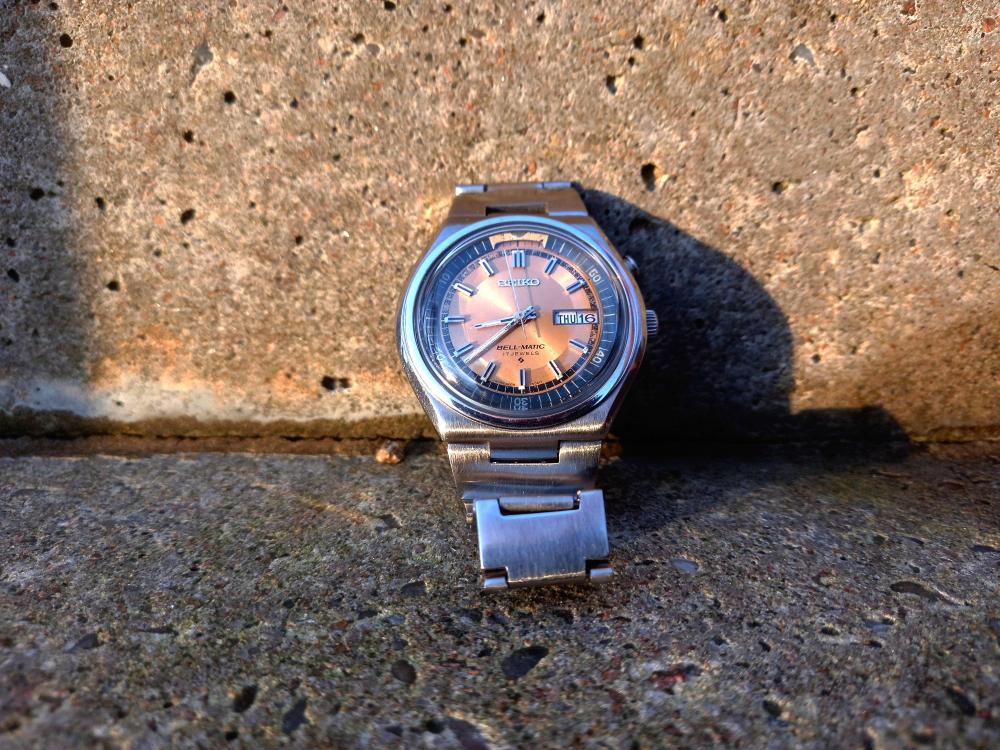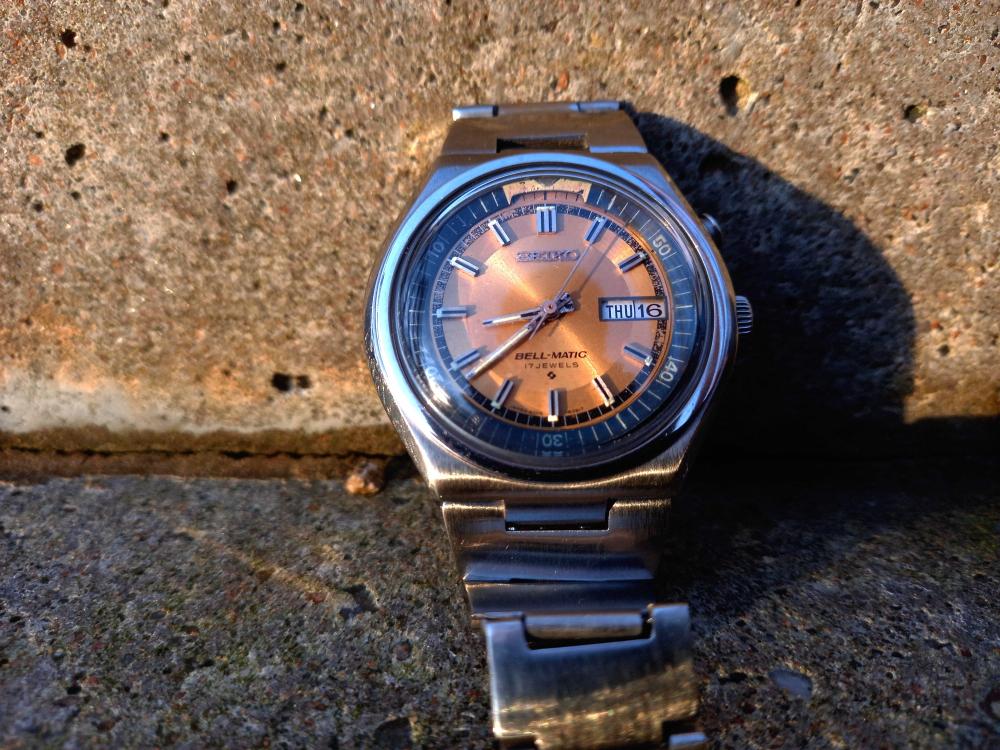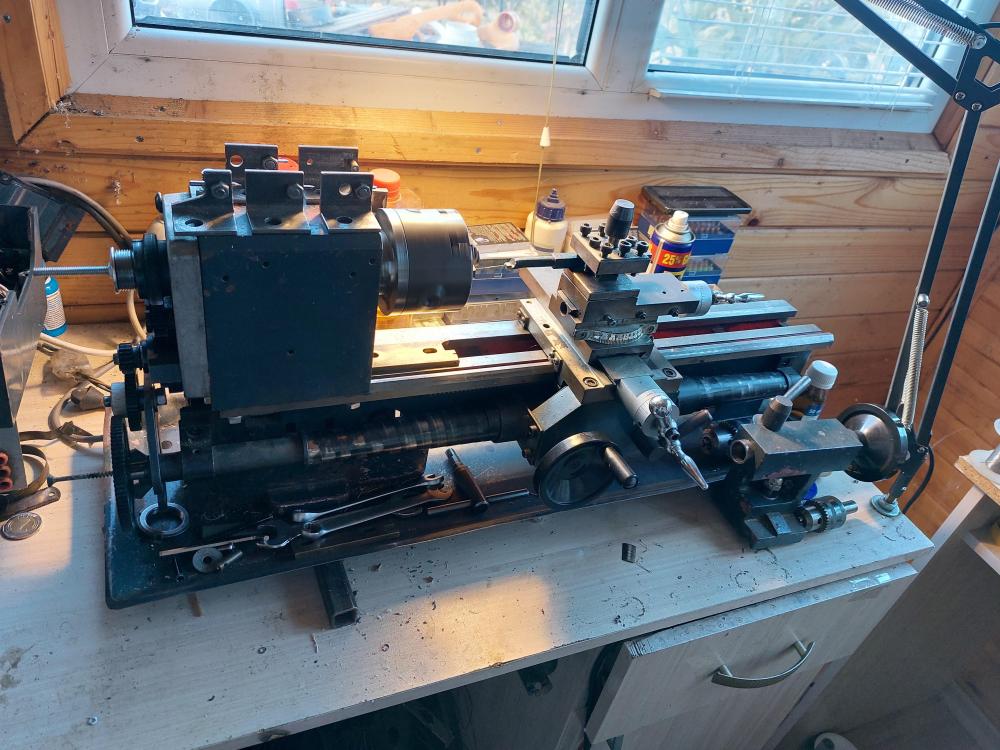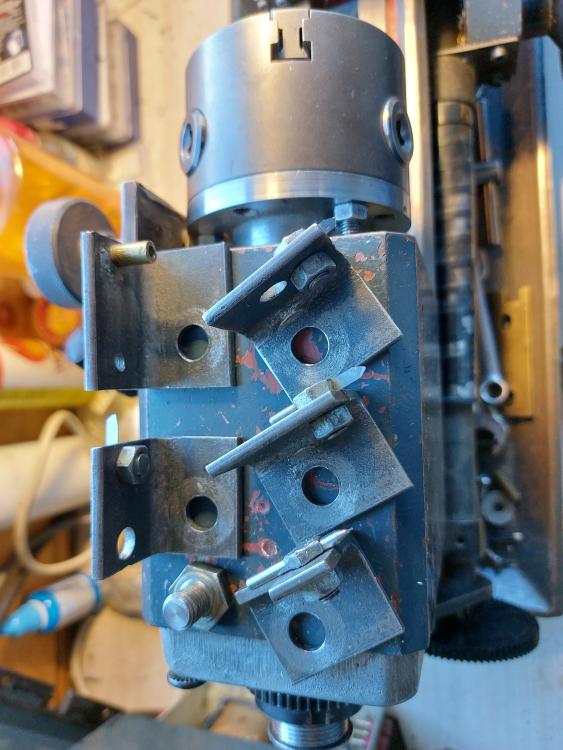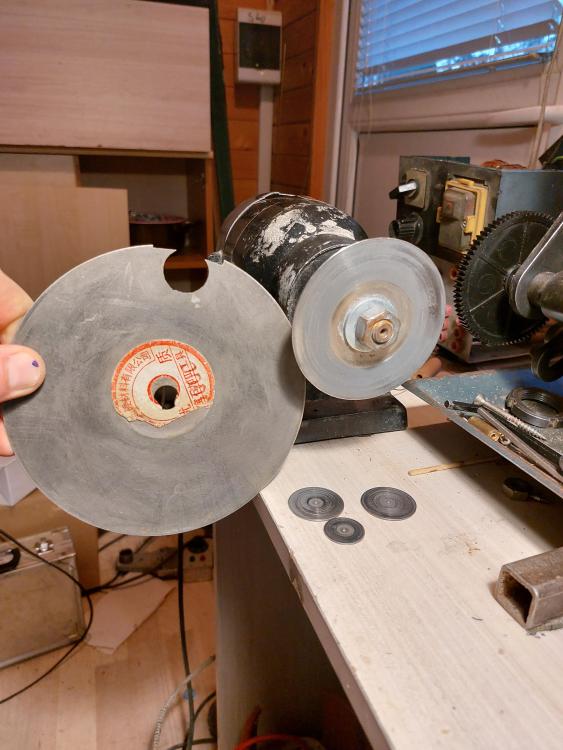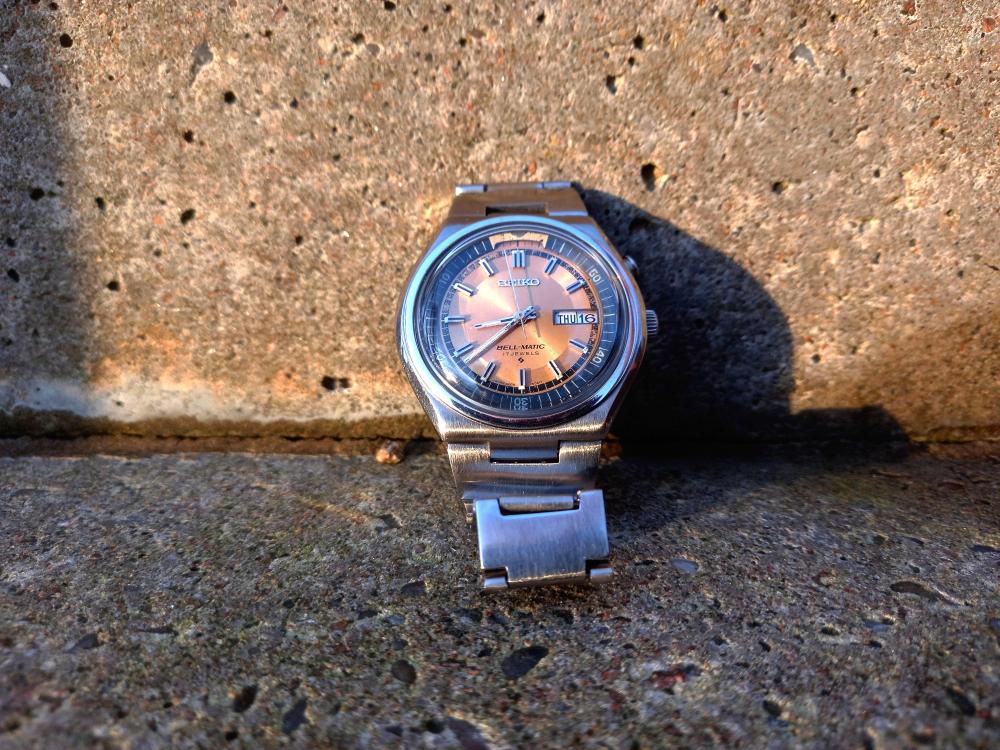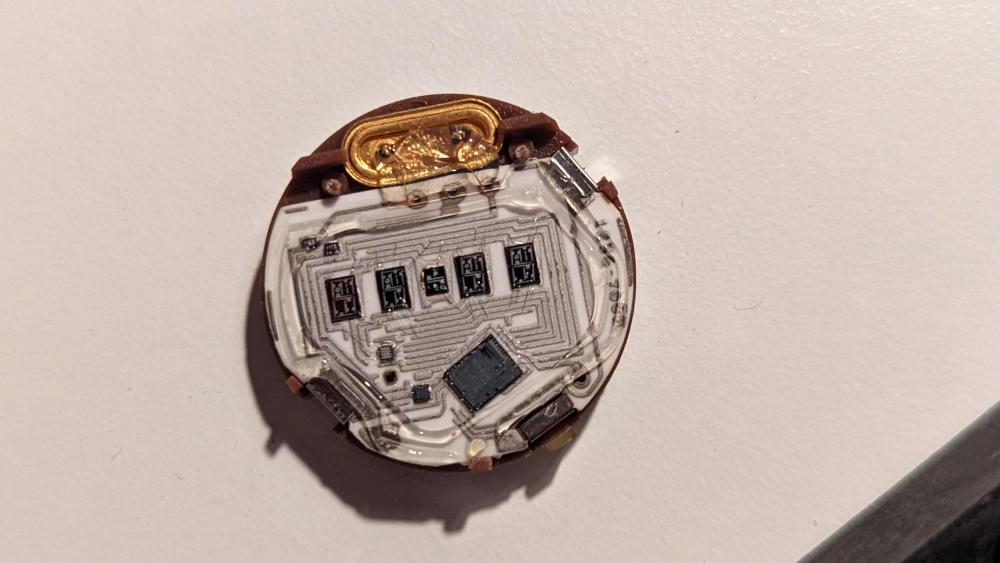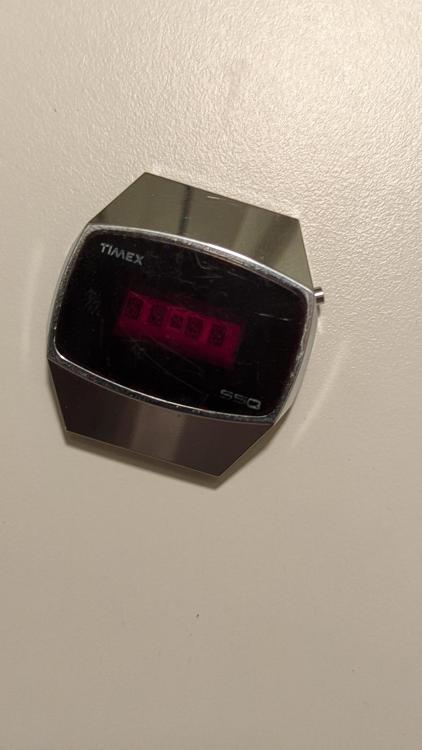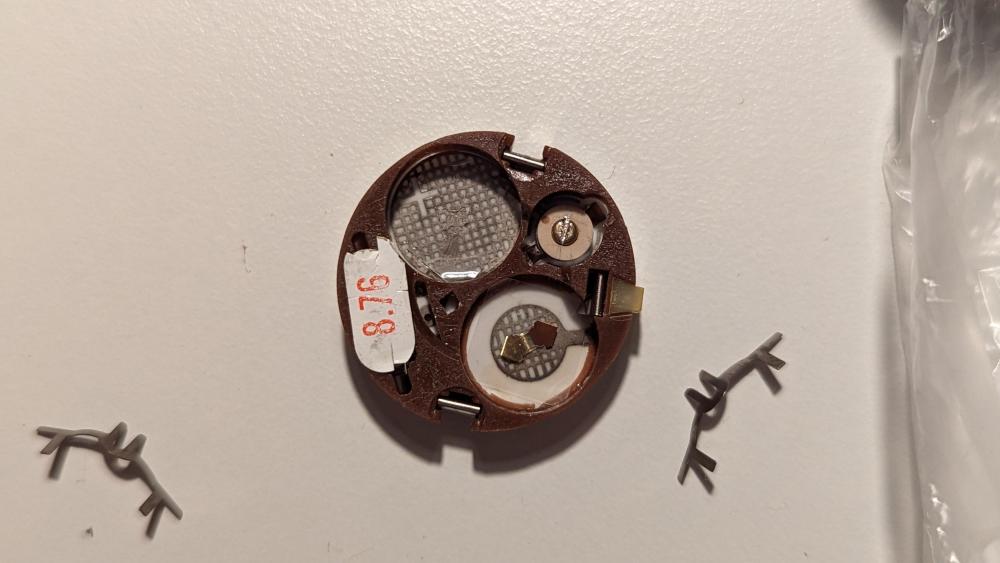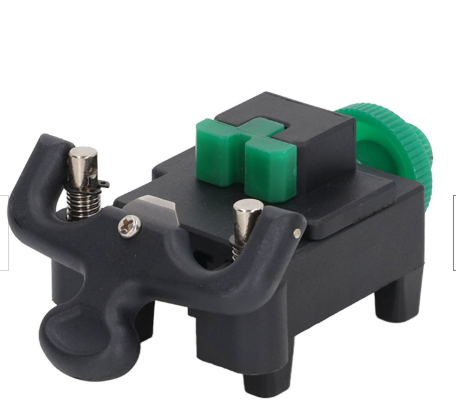Leaderboard
Popular Content
Showing content with the highest reputation on 11/16/23 in Posts
-
8 points
-
OK, I usually make balance staffs for big pocket watches out of rollers from roller bearings. This are rollers from car driveshafts bearings. I know people with car services and thus have unlimited source for material. The rollers are size 1.8-2.4mm diam. X 10-15mm, usually made of good steel and are hardened, need only tempering to deep blue. Actually, the tempering slightly depends on the steel sort, and there is a rule by G. Daniels that says 0.1mm test pivot should bent to 30 degr. before it breaks. I also check if the test pivot is normally strong, as in some cases it will break much easier than a normal pivot, and then this lot of rollers (or steel) is not good for staffs. For wrist and small pocket movements, where the pivots are thinner than 11, I usually use 115CrV3, this steel is superior to everything else that I have ever test, but I have limited quantity, it is soft and needs hardening and tempering. Working with this steel is a pleasure. I also have and use soft У10А, which is Russian analog to O1. Usually make of it screws, stems, etc. It needs very careful heating when hardening, as overheating is easy and it ruins the steel, developing big grains structure and parts break easy. Here is my main lathe, as You see it is really big and actually nothing to do with watchmakers lathe, just regular general purpose 70 cm lathe. But, I am able to make staffs for the smallest wrist calibers on it. I also make threaded parts on it, directly from blue steel, but with milling attachment instead of cutter. The interesting here is this set of cutters, which are accepted on the place of the tool post. They are pre adjusted in high and ready to use. Changing the cutter takes minimal time. The cutters are tungsten carbide and are made of CNC router bits, which are cheap and easy to source. I use this kind of diamond disks to sharpen cutters. The smaller disks are cut from a bigger one, the disks also easy to source, grit 600 or 800. I sharpen the main cutter every time when start new staff turning. If the cutter needs re-sharpening during the turning, this usually means that the steel is to-hard. If it is possible to turn 2-3 staffs without re-sharpening, then the steel is softer than needed. I have developed technic for easy maintaining the sizes in high and making one staff usually takes me about 30 min.4 points
-
Here it is. Photograph taken outside on the front step as light too poor inside. It has taken me a while, and I have learned so much. Still so much to learn. Special thanks to YouTube videos. Adam (Weekend Watch Repair), and our leader Mark Lovick (WatchFix - Watch Repair channel).Their presentations on the Bellmatic 4006a have been my bible.4 points
-
Done at 2315hrs. Wearing as I write. Photo on wrist will appear tomorrow, if it its still keeping time. Should be OK. Timegrapher was as follows. Rate +3s. Amplitude 278 degrees. Beat error 0.2. beat 19800 and 58.4 degrees Lift Angle. Date change at 11:54.4 points
-
Any jewel with a shock setting should be removable and should be removed and cleaned as part of a service. The ST36 only has shock jewels on the balance, so for that movement all the others are pressed in and not removed for service, just pegged. Right now, I'd just keep the balance complete all together and just practice removing it and placing it back. Removing the shock jewels can come later as it is a little intimidating initially.3 points
-
It varies a bit depending on what's been through, but I change every 12-15 watches. My machine holds 0.5L per bath; 1 cleaner, 3 rinses. At change I change the cleaner, and 1st rinse. 2nd rinse goes to first, 3rd to 2nd, 3rd is new. Jars get cleaned with detergent and trisodium phosphate. Cleaner and rinse are around 70 something "dollars" for 5 liters, which is around a buck a wash at that interval. Probably could stretch it?- but I'd rather not see comebacks and change theoretically too often than take the risk. Other pros I've talked to are on a similar regimen. I know 25+ years ago guys would run 3 jar machines and do dozens of cleanings (or more) between changes, but there was a different customer expectation then- cheap price ruled, it went tic tac and everyone was happy. They'd even press the case against a buffing wheel for a minute or two to shine things up all for the same low price!3 points
-
2 points
-
Thor. so pleased that you have seen the post. Could not have done it without you. It has been a trial, tribulation and project of attrition. But, I've learned so much. I even have all the parts, except for the push stem, to complete another. Future project a few years down the path me thinks. Regards to you and all the members who have assisted, cajoled and put up with me. Ross2 points
-
This question is like asking how long is a piece of string. It depends how dirty movements or parts have been. Some people filter the fluids.2 points
-
@mikepilk Great question, and I expect you will get lots of different opinions. Normally I go by the colour of the fluid, cloudiness and degree of any gunk settling out on the bottom of the jar. I try to remove anything from the bottom of the jar (once it's had time to settle) with one of those disposable plastic pipettes. If I see the colour of the entire fluid starting to change or it becomes cloudy I'll run it through some coffee filters into a new jar which often cleans it up, but I only do this one time, next time it's a 100% replacement. My version of 111 (see below) starts out a very light yellow (hydrated), and once it gets to that dehydrated "drink more water" stage I know it's time to take action. I do additional pre-cleaning of the movement, I peg the jewels as normal, but I then clean up the mainplate, mainspring barrel, bridges and any other larger items with IPA on a cotton bud (except the pallet fork and balance) which removes a lot of the gunk which would otherwise have found its way into my cleaning fluids. I make my own cleaning fluids from scratch, due to the fact I cannot buy locally and cannot import, so they are even more expensive for me and I have to mix them myself (25% ammonia makes the eyes water!), so not as easy as just opening a container and pouring. Hence, it is worth the little extra work to prolong the life of the fluid. For ultrasonic cleaning, I mainly reserve this for cases, bracelets and other "external" watch hardware, I use jars so its a new fluid every time and I use fairy liquid on these parts - I'll probably get crucified for saying this, but like I said it's only used on the case and bracelet etc and I get great results. Hope this helps, will be interesting to see other responses on this.2 points
-
I have a newly serviced automatic Vostok cal. 2416 with a decent amplitude in all positions, very small beat errors, and a mainspring with a full power reserve after a normal day of use. Despite having a healthy amplitude, beat error, and power reserve, the rate widely varies. Here are the rates I got while letting the watch rest on its back overnight in a room with the same temperature (give or take one or two degrees) night after night. Each rate represents a night’s rest of about 9 hours. +8, +7, +4, +4, +3, +4, +12, +7, +8, +14, +23, +7, +9, +16, +18, +17, +22, +21, +30, +15. I know the rate may fluctuate by a few seconds, but in this example, the rates vary between +4 and +30 seconds. Any ideas?1 point
-
That's a good question and one that I don't have the answer to. The only time I tested the power reserve was after a day of normal use and I got 33 hours out of it. The power reserve is specified to 31 hours so I have just been assuming fully would. I try winding it up fully for a few nights and will see what happens.1 point
-
1 point
-
Linux. Been down that road. Best to do everything Nucejoe and eccentric59 says. However if I may offer one piece of assistance. Use Rodico. Place it over the shock jewel spring. Replacements are not available. New movement will be needed. Trying to obtain replacement shock jewel spring is not the thing to have to do. Course is great.1 point
-
Okay. Got it. I have new hands for this movement anyway so I'll see about prying off the hand pipe off the minute recording wheel and any other wheels if necessary. Thanks to everyone for their responses as I learned something today.1 point
-
Why 'minuet'? I guess this has to be 'minute'... I wonder if You understand, but what You see on the shaft is a part of the minute register hand that broke when removing the hand, and has left on the shaft. This is not part of the movement but part of the hand. If You see such things on the other register shafts, then the other hands broke as this one. You just have to remove this pieces and throw them away, and search for new hands as well.1 point
-
That's how I do it @Waggy. I bought this tool after scratching a dial while removing a bezel using a case knife. I never liked using the case knife - there's always the possibility of it slipping and scratching something, or cutting yourself. There's no chance of that happening with this tool.1 point
-
I use about 1/3 (150ml) of what you use in my jars, and change every 5 watches. (v small ladies movements I count as 1/2 ). So similar regime. But I only have 2 rinses, and IPA. Though not doing it commercially, I have time to do a pre-clean on dirty movements : a small amount of naphtha, paintbrush and pegwood to remove old oil and gunk. The best thing I've found for cleaning the gunk from between bracelet links in the ultrasonic is naphtha. I tried SeaClean and washing up liquid, but they don't remove the gunk.1 point
-
1 point
-
Looks like the hand pipe, which is supposed to be riveted to the hand. If so it should just lever off but you will need to replace the hand.1 point
-
Kudos, the digital stuff scares me, if I get a job lot and there is one in there then I usually put it to one side if a new battery doesn't fix it. Do you have an electronics background, or are you starting from scratch?1 point
-
1 point
-
1 point
-
1 point
-
1 point
-
You have a lifetime of fun and frustration there. If you own any guns, make sure they are locked up and someone else has the key. Where are you located?1 point
-
I have a Janta Pearl machine too. Changes I've made/making: Added a main switch and replaced the power cord with a grounded plug. Grounded to the case. Remove the spring. I may put it back but shorter. Just long enough so the head won't drop on the glass bottles. I really like the 3" plumbing plug idea for bottle caps. I grabbed those when I saw it. Replace the all the tape with soldered connections and heat shrink. Ordered the automatic relay switch today from Grainger. The version mentioned above by @jimzzilla isn't available currently, so I got 21EW91 which just has a finer resolution, only goes to 102.4 seconds rather than 1024 seconds and DPDT switch 4X850. Perhaps replace the two chocolate bar (aka euro style) blocks with screw terminal blocks. Really happy with all the suggestions to fix it up. Thanks to the group!1 point
-
Yes they hairspring goes through the cleaning machine even with ultrasonic. If it's a watch it has balance jewels it can be removed. After everything is off the main plate balance wheel goes back in with its bridge screwed back down. Jewels are removed and intact that can run through the cleaning machine as the bridge on the plate install protected Pocket watch balance wheels either placed in a tiny basket or separately. As far as I know I've never had a problem from running it through the cleaning machine in the cleaning machine at work can spin quite fast we can hear it's spinning. You just don't what the balance wheel or anything else bumping into the balance wheel I suspect you have some scrap pocket watch balance wheels or even wristwatch. Run into the cleaning machine and see what happens as long as their separate are not able to fly all over the place I've never had a problem. Plus they come out nice and clean. Just remember no matter what she do always check your roller jewel especially on vintage watches they tend to get loose. I don't think that's the cleaning machine is just whatever it was that you using to hold them in place. Sometimes there loose before you even run them through the cleaning machine like the one I re-shellac today. Which is probably good I caught it ahead of time it might a full enough to cleaning machine. On the other hand the cleaning machine does have a really tiny little drain basket to catch things.1 point
-
The good thing about carpet is that the part tends to stay more or less where it lands instead of bouncing over into some hidden corner at the far end of the room.1 point
-
@rehajm many thanks for your kind words, I'm finding the right price to pitch the watches at is harder than restoring them.0 points




